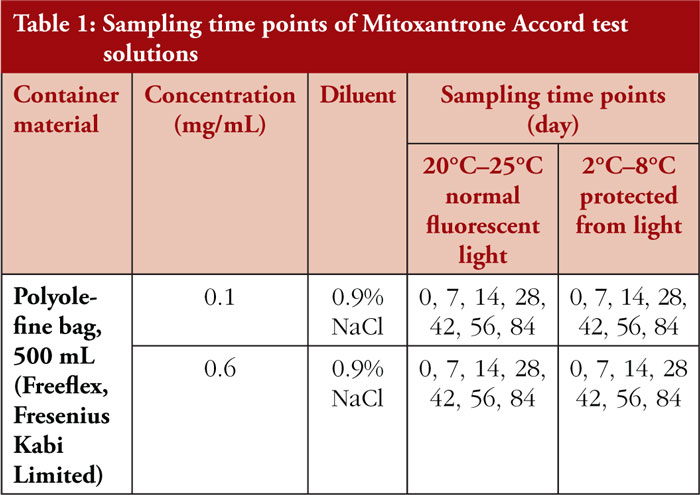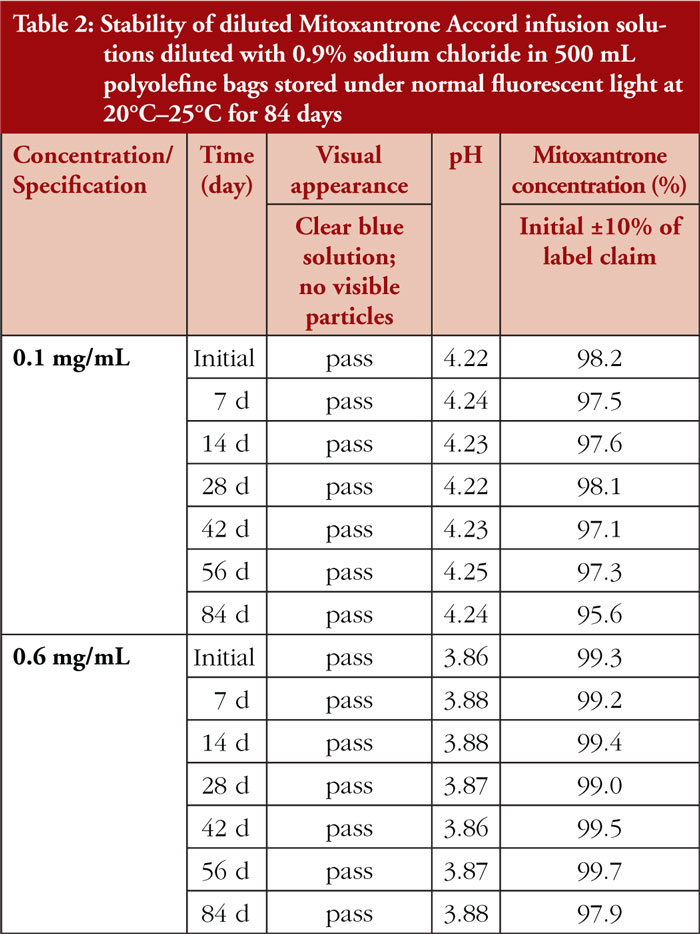Physicochemical stability of Mitoxantrone Accord after dilution with 0.9% sodium chloride solution in polyolefine bags
Published on 2024/09/11
Generics and Biosimilars Initiative Journal (GaBI Journal). 2024;13(2):71-2.
Author byline as per print journal: Irene Krämer, PhD; Frank Erdnuess, PhD; Judith Thiesen, PhD
|
Study objectives: To assess the physicochemical stability of Mitoxantrone Accord after dilution with 0.9% sodium chloride infusion solution to concentrations of 0.1 mg/mL and 0.6 mg/mL in polyolefine (PO) bags. |
Submitted: 12 February 2024; Revised: 15 April 2024; Accepted: 26 April 2024; Published online first: 6 May 2024
Introduction
Mitoxantrone is a cytotoxic, synthetic anthracenedione derivative that intercalates into DNA and inhibits topoisomerase II, thus inducing crosslinks and strand brakes. It causes cell death in both proliferating and non-proliferating cells. Approved indications include the treatment of metastatic breast cancer, non-Hodgkin lymphoma, and acute or chronic myeloid leukaemia. Furthermore, mitoxantrone inhibits B-cells, T-cells, and macrophages, and reduces the secretion of pro-inflammatory signalling molecules. Thus, it is also indicated for the treatment of highly active relapsed multiple sclerosis [1].
Novantrone® 2 mg/mL concentrated solution in original vials was shown to be physicochemically stable for 42 days after first opening [2]. Novantrone® diluted to concentrations between 0.1 mg/mL and 0.5 mg/mL revealed to be stable for up to 30 days when stored either refrigerated or at room temperature [3–6]. Physicochemical stability of Mitoxantrone Accord has been demonstrated for 7 days at 15°C–25°C or 14 days at 2°C–8°C in partially used vials [1].
Study objectives
To determine the physicochemical stability of Mitoxantrone Accord 2 mg/mL concentrate after dilution with 0.9% sodium chloride solution in polyolefine (PO) bags at two different concentrations, stored either light protected at 2°C–8°C or without light protection at 20°C–25°C for 84 days.
Methods
Mitoxantrone test solutions were prepared under EU Class A conditions and in accordance with the principles of Good Manufacturing Practice. A total of four different test solutions were prepared by diluting Mitoxantrone Accord 2 mg/mL (batch number N12000) with 0.9% sodium chloride solution in PO bags to concentrations of 0.1 mg/mL and 0.6 mg/mL. Test solutions were stored for up to 84 days. Samples were taken and analysed initially (Day 0) and at predetermined time points. For detailed information, refer to Table 1.
Physical stability was assessed by pH measurements (using a glass electrode calibrated with standard buffer solutions at pH 1.68, 4.01, 7.00, 10.01 and 12.45) and visual inspections under standard laboratory light against a black and white background for any changes in colour, clarity, or the presence of particulate matter.
Chemical stability was assessed via a high-performance liquid chromatography (HPLC) assay, which has been validated for linearity of analytical response and acceptable precision. The assay was proven to be stability-indicating for non-specific degradation of the parent drug. The acceptance criteria for all test solutions were defined as initial ±10% of the label claim.
Results
Diluted mitoxantrone test solutions in 500 mL PO bags remained physiochemically stable for 84 days, independent of storage conditions. Visual appearance and pH values of mitoxantrone test solutions remained unchanged when stored either refrigerated and light protected or at room temperature under normal fluorescent light over the 84-day test period. Neither colour change, turbidity, nor visible particles occurred. Only a slight decrease in mitoxantrone concentrations in test solutions stored at room temperature under normal fluorescent light became obvious over the 84-day test period, as shown in Table 2. Mitoxantrone concentrations in test solutions stored light protected under refrigeration remained unchanged, as shown in Table 3.
Conclusion
Mitoxantrone Accord infusion solutions 0.1 mg/mL and 0.6 mg/mL, diluted with 0.9 sodium chloride in 500 mL PO bags, proved to be physicochemically stable over the entire 84-day test period, regardless of storage conditions. Therefore, diluted mitoxantrone infusion solutions can be prepared in advance by pharmacy-based cytotoxic preparation units and used over a period of 84 days.
Analysis was performed and documented by an accredited external laboratory. Results were carefully checked for plausibility and cautiously interpreted.
Funding sources
This study was funded by Accord Healthcare.
Competing interests: The authors Irene Krämer, Frank Erdnuess, and Judith Thiesen have no competing interests to declare.
Provenance and peer review: Not commissioned; externally peer reviewed.
Authors
Professor Irene Krämer, PhD
Frank Erdnuess, PhD
Judith Thiesen, PhD
Department of Pharmacy, University Medical Center of the Johannes Gutenberg University Mainz, 1 Langenbeckstraße, DE-55131 Mainz, Germany
References
1. Accord Healthcare Limited. Summary of product characteristics for Mitoxantrone Accord 2 mg/mL solution for injection. Available from: https://accord-healthcare-products.co.uk/products/m/mitoxantrone-solution
2. Walker SE, Lau DWC, DeAngelis C, Iazzetta J, Coons C. Mitoxantrone stability in syringes and glass vials and evaluation of chemical contamination. Can J Hosp Pharm. 1991;44(3):143-51.
3. Northcott M, Allsopp MA, Powell H, Sewell GJ. The stability of carboplatin, diamorphine, 5-fluorouracil and mitoxantrone infusions in an ambulatory pump under storage and prolonged ‘in-use’ condition. J Clin Pharm Ther. 1991;16(2):123-9.
4. Adams PS, Haines-Nutt RF, Bradford E, Palmer A, Rowland CG. Pharmaceutical aspects of home infusion therapy for cancer patients. Pharm J. 1987;238:476-8.
5. Astier L, Alarcon J, Pinguet F, Canal P, Viaud P, Fety R, et al. Stability time of the anti-neoplastic drugs in the PVC infusion bags. Poster presentation at Proceedings of the 19th European Symposium on Clinical Pharmacy, Barcelona 1990.
6. Nyhammer E, Landersjö L, Sandin M, Thorson-Kaija I. Stability of Cytotoxic drugs in Pharmacia Deltec TM Medication Cassette TM. Poster presentation at 2nd Interdisciplinary Workshop on Handling Cytotoxic Drug, Hannover 1990.
7. Accord Healthcare Limited. Data for HPLC assay and acceptance criteria on fi le; 25-06-15.
|
Author for correspondence: Judith Thiesen, PhD, Department of Pharmacy, University Medical Center of the Johannes Gutenberg University Mainz, 1 Langenbeckstraße, DE-55131 Mainz, Germany |
Disclosure of Conflict of Interest Statement is available upon request.
Copyright © 2024 Pro Pharma Communications International
Permission granted to reproduce for personal and non-commercial use only. All other reproduction, copy or reprinting of all or part of any ‘Content’ found on this website is strictly prohibited without the prior consent of the publisher. Contact the publisher to obtain permission before redistributing.





